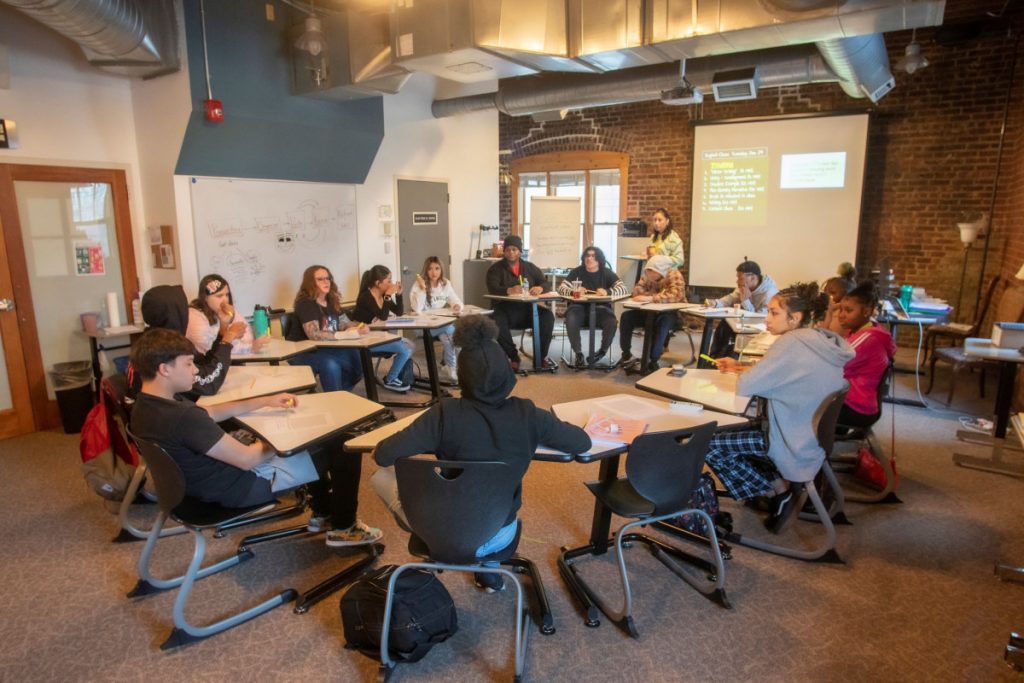Editor’s note: This article was written by Karen Ikegami, principal at RiseUp Community schools. See her full bio at the bottom of the artricle.
One evening over dinner, my 8-year-old wouldn’t stop talking about school. He was explaining his class projects and was excited for me to see his work.
You might think, “Of course! All elementary students are excited about school. But for as many families who identify with this story, there are many parents, including myself, who know that this excitement isn’t always a given.
For my family, disengagement started to creep in through seemingly inconsequential comments — nothing to share about his learning, daily reports of the “drama” in the school, and a shrug when asked about school. As a school principal, I worried these small signs of disengagement would eventually lead to daily arguments about going to school. I worried we were on the path to chronic absenteeism.
Good attendance isn’t as simple as just showing up. School staff often look at poor attendance and ask, “Why don’t they go to school?” My school, RiseUp Community School, battled poor attendance for six years.
Each year, we consulted various national resources to find attendance improvement strategies to implement. And each year we felt demoralized by the results. We didn’t need complex data calculations to see the lackluster results we were getting for our students.
After six years of feeling like we were still at square one, we weren’t sure our initial question was right. Schools know that good student attendance is foundational, making it feel critically urgent to get it “right.” Our poor attendance led me to moments of panic and frustration.
It’s often in these moments when I remember Desmond Tutu’s quote, “There comes a point where we need to stop just pulling people out of the river. We need to go upstream and find out why they’re falling in.”
RiseUp is an alternative school and often one of the reasons that students come to us is because they have stopped going to school. Yet, chronic absenteeism isn’t something that happens overnight. It is often a result of various challenges in and outside school buildings and may still occur despite everyone’s dedicated efforts.
Taking a humanistic approach
We knew the methods we were using to deal with poor attendance weren’t working. We theorized that part of the solution might not look linear. We had to put ourselves in the shoes of our parents and ask ourselves new questions. Why, on the hardest days and in the hardest situations, might I move mountains to get my student to school? And when might I not?
For the sake of this exercise, let’s take a minute to consider this question. When you’re having a bad day, who do you want to see? Who is going to have your back? What would you still make the effort to show up to? Here’s how we answered those questions.
We didn’t start answering attendance questions with a school-based lens; instead, we took a humanistic approach. We realized we needed to build real relationships with families, showing them we would care for their most precious ones with love and attention. We hoped this would be a change from the rigid systems they had perhaps experienced previously.
We started simply. Staff would hold quarterly family meetings. No more effort would be put into attendance initiatives (incentives, letters, attendance plans). Instead, each family would meet one-on-one with a staff member to have an informal conversation about home, goals, and how school was going. We had no way of knowing the floodgate we were opening.
It’s important to note that the changes we made took place in the fall of 2020. RiseUp had four previous years of poor performance as measured by the SPF. After five years, a charter school would likely close. This sense of urgency does not lend itself to taking risks.
We knew the Colorado state School Performance Framework accountability measurements would be on hold for the 20-21 school year because of the pandemic. This pause on accountability gave us some breathing room to try an unconventional approach we probably otherwise would not have tried. While the pandemic hindered us in many ways, we also recognized the momentous opportunity it gave us to partner more closely with parents.
Improvements, year over year
In year one, our goal was to meet with 75% of our families. We hoped to have families drive these meetings, but they ended up being mostly information sharing. In year two, our added hope was that families would guide the conversations so we provided example questions they might ask. We tracked the number of families that asked questions and shared this back with families in our newsletter, and this is when things started to get interesting!
In year three, families showed up to the meetings with their own questions in hand. They wanted to know about attendance, grades, behavior, attitudes, and best of all, how they could support post-secondary planning. This was not information we were prepared with! I
n year four, family requests for information drove the creation of a new data system to quickly pull and visualize data, weekly progress and attendance report emails, new data teams, and an entirely new internship program. Since implementing our family meetings, overall attendance has increased by 10-13%, standardized test scores have improved, work quality has gone up, course passing rates have increased, and graduation rates have gone up.
We’ve started the process to connect all students with internships and concurrent enrollment and to fundamentally change the educational program of the entire school.
And you can feel it when you walk through our building; it’s bursting with energy.
The biggest change indicative of our work to connect with families is that we see more families in our building. Parents and guardians are reaching out more, asking deep questions about their students’ educational experiences. Attendance at parent-teacher conferences has risen from 2% to 86%, with parents actively contributing ideas.
As a community school, this is the most ideal change we could have ever hoped for. It feels like the school is truly a school for the community.
Improving family communication impacted more than just attendance, which is complex on its own. At RiseUp, we understand attendance not as an initiative but as a data point reflecting how well the school shows up as an active family partner.
As a parent, helping your student have great attendance is a collaborative effort. I need my child’s school to be warm, welcoming, challenging, and fun. I also need my child’s school to give me the information I need to support what happens in the school.
This includes attendance information, but also special events, what they’re studying, and ways I can volunteer to bridge the divide between home and school.




